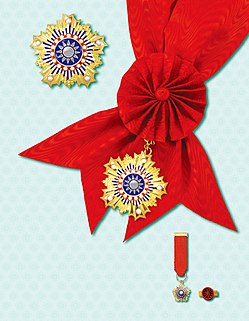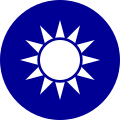| Order of Brilliant Jade | |
|---|---|
 Order of the Brilliant Jade cordon, badge, star, medal and lapel pin | |
| Type | Single-grade Grand Cordon |
| Awarded for | The President of the Republic of China and foreign heads of states |
| Description | The medal has a star-patterned face of inlaid jade bordered with gold and pearls. The center is the "white sun in a blue sky," the national emblem of the ROC, symbolizing a tribute to the head of state internally and the strengthening of friendly ties with other countries externally. |
| Country | |
| Presented by | President of the Republic of China (Taiwan) |
| Eligibility | Civilian |
| Status | Active |
| Established | 22 December 1933 |
| First award | Lin Sen |
| Total | 24 |
| Ribbon bar of the Order | |
| Precedence | |
| Next (higher) | none |
| Next (lower) | Order of Dr. Sun Yat-Sen |
| Order of Brilliant Jade | |||||||
|---|---|---|---|---|---|---|---|
| Traditional Chinese | 采玉大勳章 | ||||||
| Simplified Chinese | 采玉大勋章 | ||||||
| |||||||
The Order of Brilliant Jade is a civilian order of the Republic of China that can be worn only by a head of state. According to regulations,the order can only be presented by the president or monarch of the country or an emissary expressly dispatched to friendly countries for the conferment. The order was instituted on 22 December 1933. [1] It has a star-patterned face of inlaid jade bordered with gold and pearls. In the centre there is white sun surrounded by blue sky,the national emblem. [2] Previously,the Order of the Brilliant Jade was divided into two,namely Grand Order of Brilliant Jade (current) and Order of Brilliant Jade with nine ranks.
